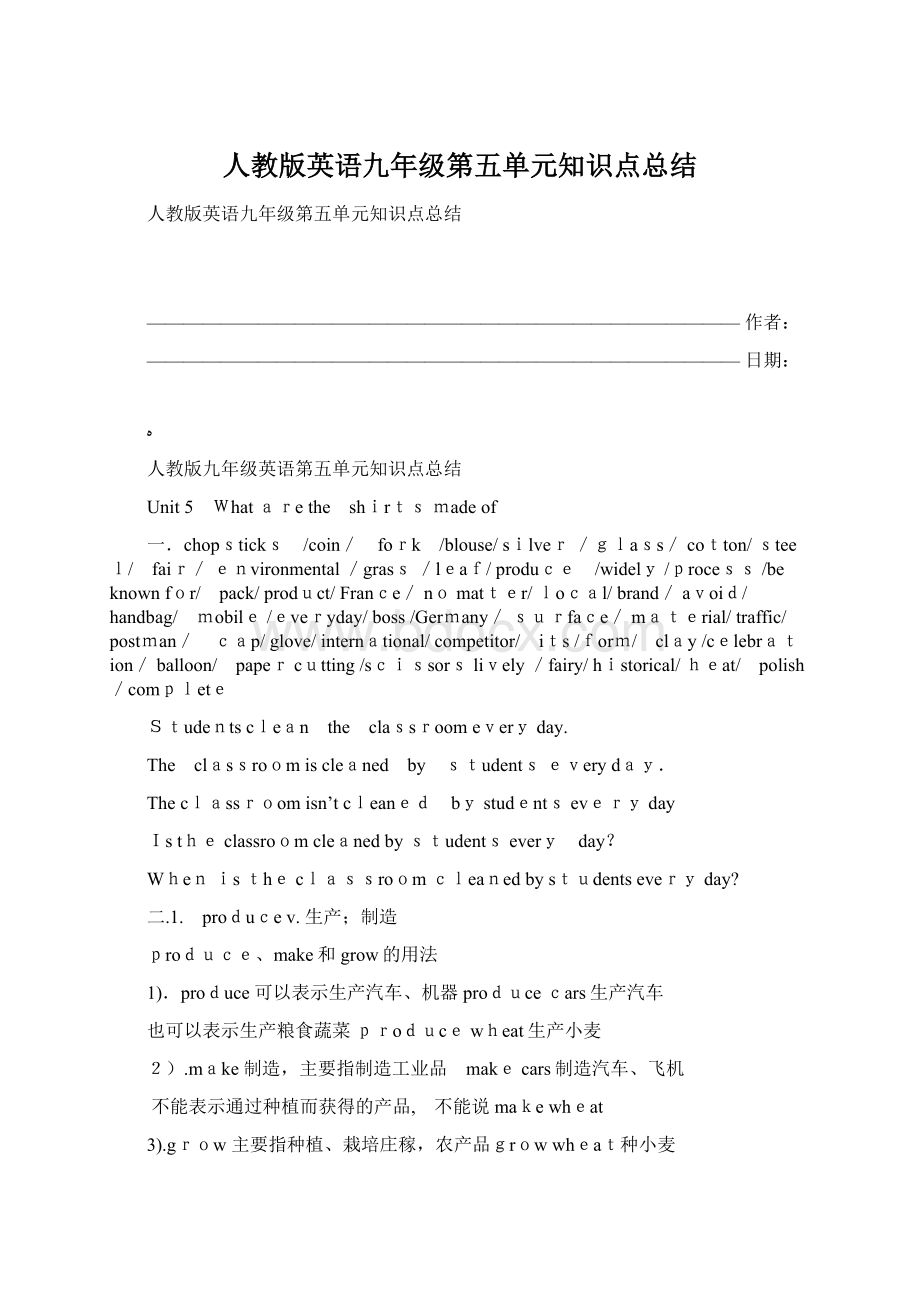人教版英语九年级第五单元知识点总结.docx
《人教版英语九年级第五单元知识点总结.docx》由会员分享,可在线阅读,更多相关《人教版英语九年级第五单元知识点总结.docx(9页珍藏版)》请在冰豆网上搜索。

人教版英语九年级第五单元知识点总结
人教版英语九年级第五单元知识点总结
————————————————————————————————作者:
————————————————————————————————日期:
ﻩ
人教版九年级英语第五单元知识点总结
Unit5 Whatarethe shirtsmadeof
一.chopsticks /coin/ fork /blouse/silver/glass/cotton/steel/ fair/environmental/grass/leaf/produce /widely/process/beknownfor/ pack/product/France/nomatter/local/brand/avoid/handbag/ mobile/everyday/boss/Germany/surface/material/traffic/ postman/ cap/glove/international/competitor/ its/form/ clay/celebration/balloon/ papercutting/scissorslively/fairy/historical/heat/ polish/complete
Studentsclean the classroomeveryday.
The classroomiscleaned by studentseveryday.
Theclassroomisn’tcleaned bystudentseveryday
Istheclassroomcleanedbystudentsevery day?
Whenistheclassroomcleanedbystudentseveryday?
二.1. producev.生产;制造
produce、make和grow的用法
1).produce 可以表示生产汽车、机器produce cars生产汽车
也可以表示生产粮食蔬菜produce wheat生产小麦
2).make 制造,主要指制造工业品 make cars制造汽车、飞机
不能表示通过种植而获得的产品, 不能说make wheat
3).grow 主要指种植、栽培庄稼,农产品grow wheat种小麦
Many ofusknows howto ____tea,butfewknowswhereteatreesare_____.
A.make,made B.grow,grown C.produce,made D.make,grown
根据题意可知,第一空“是怎样泡茶”make tea;第二空是“种茶树”growteatrees
2.GermanGermansGermany
3.lively
1)live “活着的”,通常指物,不指人,常用来作定语放名词的前面。
还指“实况转播的”。
例如:
ﻫa live fish 一条活鱼。
ﻫDo you like a live show or a recorded show ?
2)living意为“活着”强调说明“尚在人间”,“健在”,可用来指人或物,作定语或表语。
例如:
.My first teacher is still living .English is a living language .
A living language should be learned through listening and speaking .
He is regarded as one of the best living writers at present .
注意:
living 前加上 the , 表示类别,指“活着的人们”。
例如:
ﻫThe living must finish the work of those dead . ﻫliving 还可用于短语,例如:
make a living 谋生。
ﻫ3)alive 意为“活着”,侧重说明生与死之间的界限(本来会死但没有死),既可指人,也可指物;可用来作表语,后置定语或宾补。
例如:
The badly wounded soldier was still alive whenhewas taken to the hospital .He is dead , but his dog is still alive . He wanted to keep the fish alive . Thisisafish alive.
4)lively 则意为“活泼的”,“活跃”,“充满生气的”,可作定语、表语或宾补,既可指人,又可指物。
例如:
Jenny is a lively girl . Everything is lively here . 这儿一切都生机勃勃。
He had a strange way of making his classes lively and interesting .
live
物
定语
现场的
living
人/物
定语、表语
makea living/theliving
alive
人/物
后置定语、表语、宾补
生与死的界限
lively
人/物
定语、表语、宾补
生气勃勃的,无活着的意思
4.avoid +doing
5.bemade of/be madefrom/be made by/bemade into/be madein/bemadeupof由…构成或组成的。
Our classis madeupofsix groups.
6.beknown/famous/well-knownfor beknown/famous/well-known as
be known/famous/well-knownin beknown/famous/well-knownto
7. begood(bad) for/be goodto/begoodwith/begoodat(do wellin)
begood for
对……有益
后接表示人和事物的名词
be goodto=bekind/friendlyto
对……友好
后接表示人的名词
be goodat=dowell in
擅长……
后接名词、代词或动名词
begood with=get on/alongwith
与……相处融洽
后接表示人的名词
8.主谓一致
both..and…/and
Theteacherandthewriterarecoming.
The teacherand writer iscoming.
Bothyouand Iaregoodstudents.
notonly…but (also)…/neither…nor/either…or
as well as/morethan/with/togetherwith/along with/like/except/besides/including
every/each/no/noone/some(any,no,every)+body(one/thing)主语或主语限定词
分数+of+n由分数后的名词单复数决定halfof theapple/half ofthe apples
5.seem to dosth=Itseemsthat…看起来似乎
Theyseemtofindtheway tothe cinema.=Itseemsthattheyfind thewayto the cinema.
6.turnup/turn down/turnon/turnoff/turninto=changeinto
turnto转向;翻到(某页) ;求教于;turn around
7.find意为“找到、发现”,通常指找到或发现具体的东西,也可指偶然发现某物或某种情况,强调的是找的结果。
look for意为“寻找”,是有目的地找,强调“寻找”这一动作。
findout意为“找出、发现、查明”,多指通过调查、打听、研究之后“搞清楚、弄明白”,通常含有“经过困难曲折”的含义,指找出较难找到的、无形的、抽象的东西
Thepolice is visitingthe neighborhood andtrying to____thetruthof the fact.
A.lookfor B.searchC. findD.findout
8.no matter+what/when/where=whatever /whenever/wherever “无论什么/什么时候/哪里”
9.glass指玻璃时为不可数名词,指玻璃杯时为可数名词,指眼镜时必为复数(多以apairof修饰)
10.everyday为形容词,每日的,every day多做状语,每天
11.find/think/believeitadj. to do
12.all/differentkindsof各种各样的a kindof一种 kind of有点(=alittle/bit)
13.beseen as=beregardedas=betreatedas被视作
14.for example/suchas
15.四个“花费”句型
16.过去分词做后置定语aboycalledLilei=aboy namedLilei
17.scissorsn剪刀(常用作复数,作主语时谓语用复数)apairof scissors一把剪刀
成双成对的名词只有复数形式,类似的词还要:
jeans牛仔裤trousers裤子shorts短裤 glasses眼镜 shoes鞋
“apair of +复数名词”做主语时,谓语动词与pair的形式一致。
This ___________is madeofmetalandplastic.
A.pairofscissors B. scissors C.piece of scissors
18.pack打包;一包apackofeg:
I boughta packof gum.(牙签)
competev-competitor ncompetewith sb
completev+doing;
18.全世界(3)即使 (4)由...制成的(表示制成成品后,仍可看出原材料是什么)/由...制成的(在成品中已无法辨认原材料)/在......制造/由…制造/被制成…./被…制造/由…组成/在......生产/因...闻名/作为…而闻名/在…闻名/为…知晓/被用于...
(2)/不论/据我所知/用手采摘/对……有益/擅长/对…友好/对…相处融洽/在每个月的最后一个星期五/制造高科技产品/在地球表面/许多不同种类的/例如/根据,按照/作为……的象征/张贴/好运/在高温下/在山腰上/在…边上/造成交通事故/把……变成……/处于困境中/上升,上涨/剪纸/在春节期间/孔明灯/尽力做某事/环境保护/派人去请/避免做某事/日常用品 /查明;弄清/去度假/发出(光亮,声音);放出;生出 /童话故事/一幅美丽的画/覆盖(3)/传统艺术的特殊形式/在周围,存在/热气球/中国陶土艺术/陶土作品/历史故事/飞机模型/不仅在过去还在现在/他们自己的/被看作是(3)/地下停车场/关于…的研究/例如
(2)/艺术与科学展览会/事实上/放风筝/幸福的光明象征/被送去加工/一个17岁学生 /美国品牌/好运/被画上.../精美物品
19-裙子(酒)是由什么制成的?
在哪儿被制成的?
由谁制成的?
-是由丝绸制成的。
在美国制成。
由王叔叔制成。
-戒指看起来很好看,它是由银的制成的吗?
-是的,它是。
语法全解
被动语态
A.熟记结构
一般
进行
完成
完成进行
现在
do
Isdone
isdoing
isbeing done
havedone
havebeendone
havebeendoing
have beenbeing done
过去
did
Was done
wasdoing
wasbeing done
had done
had been done
hadbeendoing
hadbeen being done
将来
willdo
will bedone
will bedoing
willbebeing done
will havedone
willhave beendone
willhave beendoing
will have beenbeing done
过去将来
woulddo
wouldbedone
would bedoing
wouldbebeing done
wouldhave done
would havebeen done
wouldhavebeendoing
would havebeen beingdone
注意;被动语态变化即把主动的动词V用be动词的对应形式代替+动词的过去分词(V-ed)如;Will+V be + V-ing
Will +be+过分 be+ be-ing+过分
含有情态动词的被动语态由“情态动词+be+done”构成。
1.Chinese ______bythelargest numberofpeople.
A.speak B.isspeakingC.speaksD.isspoken
2.Theboy______togetsupperreadyafterschool.
A.weretoldB.istellingC.was toldD.tells
3.Alot ofnew roads______builtinthewestofChina.
A.mustB.mustbeC.hasD.have
B.明确用法
被动语态常用于以下两种情况:
1.不知道谁是动作的执行者,或者没有必要指出谁是动作的执行者;
2.强调动作的承受者。
例如:
这棵树是那个男孩弄断的。
Thetree____________ bythat boy.
C.熟练转换
1.将主动语态变被动语态的基本方法为:
①主变宾;②谓语动词变为被动;③剩余照抄。
By+主语变成的宾格。
2.被动语态的一般疑问句是将一个助动词置于主语之前;否定句是在第一个助动词后加not;特殊疑问句的语序为:
疑问词+一般疑问句。
例如:
Youmustthrow thebrokenbottleaway atonce.
Thebrokenbottle ________________________atonce.(同义句)
Where didtheygrowvegetables?
(改为被动语态)
Where______vegetables______?
D.注意特例
将主动语态变被动语态应注意几个特殊情况:
1.含双宾语的主动结构变为被动结构时,有两种方法:
①将间接宾语变为主语,直接宾语保持不变;
②将直接宾语变为主语,间接宾语用介词to或for引导。
例如:
Hetoldusastory.(变被动语态)
→Weweretolda story(by him).或:
Astorywastold tous byhim.
双宾语,很奇特,被动语态有两个,用人简单用物难,难在人前to, for添
常见的接双宾语的动词有:
to:
(1)pass sbsth=pass sth tosb (2)give sbsth=give sth.to sb
(3)teachsbsth=teachsth to sb,(4)showsbsth=show sthtosb
(5) bringsbsth=bring sthtosb, (6)sendsb sth=send sth tosb
(7)handsbsth=handsthtosb (8) sellsbsth=sellsthtosb
(9) takesbsth=takesthto sb(10)write sbsth=write sth tosb
for:
(1)makesbsth=makesthforsb
(2)buysbsth=buysthforsb
(3)getsb sth=getsthforsb (4) cooksbsth=cooksthforsb
(5)keepab sth=keepsth forsb (6) sing sbsth=singsthforsb
(7) findsbsth=findsth for sb (8)performsb sth=perform sthforsb
既可用for也可用to的词:
read
练习:
把主动语态变为被动语态。
(两种办法)
1.Hebought meapresentyesterday.
___________________________________ ________________________________________
2.Ihavewritten himaletter.
___________________________________ _______________________________________
2.短语动词的被动语态:
在变为被动语态时,要将短语动词视为一个整体,其后的介词或副词不能省去。
例如:
① Thisdictionarymustn't______fromthelibrary.
A.takeawayB.takenawayC.aretaken away D.betakenaway
②Shewilltakegoodcare ofthe children.(变被动语态)
The childrenwill____________ ______ ____________(byher).
3.see sb. dosth.→beseentodosth. (see sb.doingsth.→beseendoing sth.)(watch/hear/notice
find等也适用于以上结构)
make/let/havesb.do sth. →sb.be made/had/lettodosth.
4.有些动词既是及物又可以做不及物,当它们和well,badly, easily,smoothly等副词连用时,表示主语内在品质性能为不及物,只能用主动,常见的有sell, write,cook,wash,write.
The bookssellwell/Thebooksaresoldout.
5感官动词用主动表被动。
如feel/look/ taste/sound. Itfeelssoft.
6.某些不及物动词不能用作被动。
如happen/takeplace/begin/comeout/ last
7.allowsb.todosth. allowdoingsth. beallowedtodosth
Theydon’tallow smoking. Mymotherallowsme towatchTV.
人+need todo物+needdoing=needto be done
8.牢记(相关)句型
beusedfor/ beusedtodosth.Itissaidthat... Itishopedthat...
It iswellknownthat...
Thismachine isused______ the roomwet.
A.forkeeping B.askeepingC.keepD.tokeeping
据说在南京长江上又在建一座桥。
____________ ______that ______ ______isbeing______over theChangjiangRiverinNanjing.(填Itissaid;anotherbridge;built)
不规则过去分词
be/bear/beat/become/begin/blow/break/bring/build/burn/buy/catch/choose/come/cost/cut
deal/dig/do/draw/dream/drink/drive/aet/fall/feed/feel/fight/find/fly/forget/get/give/go
grow/hang/have/hear/hide/hit/hold/hurt/keep/know/lay/lead/learn/leave/lend/let/lie/light
lose/make/mean/meet/mistake/overcome/oversleep/pay/put/read/ride/ring/rise/run/say
see/sell/send/set/shake/shine/show/shut/sing/sit/sleep/smell/speak/speed/spell/spend
spread/stand/steal/stick/swim/take/teach/tell/think/throw/understand/wake/wear/win
write